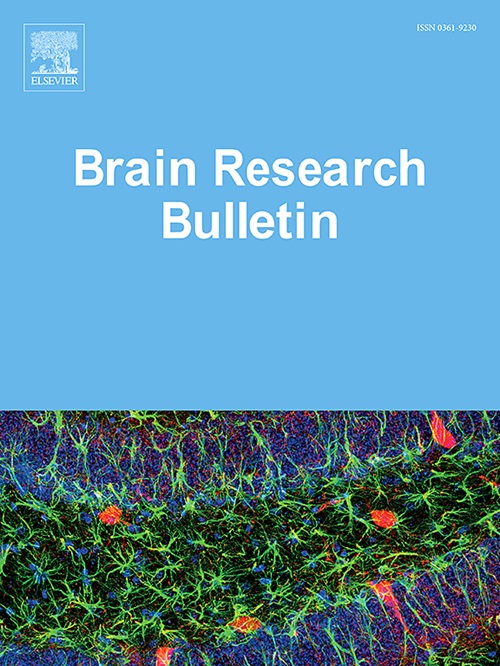地磁风暴对低气压的影响及其机制研究
IF 3.5
3区 医学
Q2 NEUROSCIENCES
引用次数: 0
摘要
抑郁症在世界范围内已成为一种致残疾病。地磁风暴与抑郁行为密切相关,褪黑素是抑郁症发病的重要因素。本研究观察了不同强度地磁风暴对抑郁症大鼠褪黑素的影响。目的为地磁风暴期间抑郁症及其他褪黑素相关精神疾病的防治提供理论依据。方法将慢性不可预测轻度应激(CUMS)大鼠置于不同强度地磁暴环境7 d。通过称重、蔗糖偏好试验、升高加迷宫试验、新奇性抑制喂养试验和空地试验来测定CUMS大鼠的抑郁行为。然后,通过使用试剂盒、qPCR分析、免疫荧光染色和western blot分析褪黑素合成、褪黑素代谢和褪黑素受体途径相关指标。探讨不同强度地磁对CUMS大鼠的影响及其分子机制。结果中度地磁暴(50 nT)通过增加褪黑素合成、代谢和MT1受体通路活性来保护CUMS大鼠抑郁行为,而极端地磁暴(500 nT)和屏蔽地磁暴(0 nT)抑制褪黑素合成、代谢和MT1受体通路,加重损伤。结论中度地磁暴(50 nT)对CUMS大鼠的抑郁行为有保护作用,而极端地磁暴(500 nT)和屏蔽地磁暴(0 nT)加重了CUMS大鼠的抑郁行为。本文章由计算机程序翻译,如有差异,请以英文原文为准。
Research on the effects and related mechanisms of geomagnetic storm on depression
Objective
Depression has become disabling disease in the world. Geomagnetic storm is closely related to depression behavior, and melatonin is an important factor in the pathogenesis of depression. This study observed the effects of different intensities of geomagnetic storm on melatonin in depressed rats. Aim to provides a theoretical basis for the prevention and treatment of depression and other melatonin related mental illnesses during geomagnetic storms.
Methods
In this study, rats with chronic unpredictable mild stress (CUMS) were exposed to geomagnetic storms of different intensities for 7 days. The depressive behavior of CUMS rats was determined via the weigh, sucrose preference test, elevated plus maze test, novelty-suppressed feeding test and open field test. Then, through the use of kits, qPCR analysis, immunofluorescence staining and western blot analysis of melatonin synthesis, melatonin metabolism and melatonin receptor pathway related indicators. Performed to explore the effects of different intensities of geomagnetism on CUMS rats and the related molecular mechanisms.
Results
The reults showed moderate geomagnetic storms (50 nT) protected against depressive behaviors in CUMS rats by increasing melatonin synthesis and metabolism and MT1 receptor pathway activity, while a extreme geomagnetic storms (500 nT) and shielding from geomagnetic storms (0 nT) inhibited melatonin synthesis and metabolism and the MT1 receptor pathway and aggravated injury.
Conclusions
In this study we found moderate geomagnetic storms (50 nT) protected against depressive behaviors in CUMS rats, while a extreme geomagnetic storms (500 nT) and shielding from geomagnetic storms (0 nT) aggravated injury.
求助全文
通过发布文献求助,成功后即可免费获取论文全文。
去求助
来源期刊

Brain Research Bulletin
医学-神经科学
CiteScore
6.90
自引率
2.60%
发文量
253
审稿时长
67 days
期刊介绍:
The Brain Research Bulletin (BRB) aims to publish novel work that advances our knowledge of molecular and cellular mechanisms that underlie neural network properties associated with behavior, cognition and other brain functions during neurodevelopment and in the adult. Although clinical research is out of the Journal''s scope, the BRB also aims to publish translation research that provides insight into biological mechanisms and processes associated with neurodegeneration mechanisms, neurological diseases and neuropsychiatric disorders. The Journal is especially interested in research using novel methodologies, such as optogenetics, multielectrode array recordings and life imaging in wild-type and genetically-modified animal models, with the goal to advance our understanding of how neurons, glia and networks function in vivo.
 求助内容:
求助内容: 应助结果提醒方式:
应助结果提醒方式:


